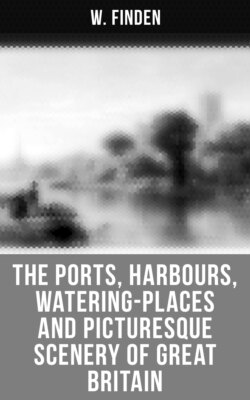Читать книгу The Ports, Harbours, Watering-places and Picturesque Scenery of Great Britain - W. Finden - Страница 15
На сайте Литреса книга снята с продажи.
SCARBOROUGH.
ОглавлениеTable of Contents
In this view of Scarborough, by Harding, which is taken from the southward, the most conspicuous object is the Lighthouse on the Old Pier, or, as it is sometimes called, Vincent's Pier, from the name of the engineer, by whom the outer portion was erected about the year 1750. Beyond the pier are seen the masts of vessels lying in the harbour; to the left are the houses, which are built near the shore between West Sand-gate and Bland's Cliff; and on the height are the barracks, with the ruins of the old castle, a little further distant, to the left.
Though the name of Scarborough appears to be of Saxon origin, yet as the place is not mentioned in any author who wrote before the Conquest, nor in the Domesday-book, we cannot reasonably suppose it to have been of much importance, either during the Saxon period, or at the time when the Conqueror's survey was made. The castle of Scarborough was built about 1163, by William le Gros, Earl of Albemarle and Holderness; and from that period the authentic history of the town commences. The castle is situated to the north-eastward of the town, and is built on the isthmus of a peninsula, which comprises an area of about sixteen acres, and is bounded on the north, east, and south by inaccessible cliffs, whose summits are about 300 feet above the level of the sea. The western boundary, overlooking the town, is also formed by an elevated rock; and the only means of approach to the castle is by a steep path near the edge of the cliff forming the north side of the isthmus. On passing through a gateway, and over a draw-bridge, we arrive at the castle, which, previous to the introduction of cannon, must have been almost impregnable. The keep or principal tower is ninety-seven feet high, and though greatly dilapidated, is yet a striking object, more especially when viewed from the sea, at about two miles' distance from the north cliff.
There is no river at Scarborough; and the harbour, which is formed by the piers, is only accessible towards high water. It is high water at Scarborough at forty-five minutes past three o'clock at the full and change of the moon; and at spring tides there is about twenty-two feet water at the end of the pier. At night a light is shown from the lighthouse as long as there is twelve feet water at the entrance to the harbour; and during the same period a flag is hoisted by day.
About 1620 the sanative virtues of the Spa-well were discovered by Mrs. Anne Farrow, who "sometimes walked along the shore, and observing the stones over which the water passed to have received a russet colour, and finding it to have an acid taste different from the common springs, and to receive a purple tincture from galls, thought it probably might have a medical property." The lady having tried the water herself, and persuaded others to do the same, it was in a short time pronounced an all-heal, and the people of the place took it as their usual physic. Before 1670 these waters had become celebrated, and many persons resorted to Scarborough for the sake of drinking them. Medical men, however, disagreed both as to their composition and effects; and the opinions of Dr. Witty, a resident physician, who recommended them in every case, were controverted by Mr. Simpson and Dr. George Tonstall. The latter says of the Spa-water, "The essence is fit for the cup of a prince; the caput mortuum, which is sand and clay, is fit for nothing but the bricklayer's trowel. Hence it doth follow that those who are weak in their digestive faculties, and strong in their distributive, may find good by drinking this water; but those who are weak in both will experience the contrary." From the following anecdote related by the doctor, we may infer that the spa-drinkers of that period were accustomed to indulge in rather copious draughts. "Mr. Westro came to us at Scarborough only to visit his friends, and the two or three days he drank the waters (not above two quarts at a time), did so far put him out of tune, that he made his complaint to me he could neither eat nor sleep; and it took me a week's time before I could reduce him to the state of health which he had before he meddled with the waters." He would have been a person of strong constitution indeed not to have been "put out of tune" by such drenching; and it is no small proof of Dr. Tonstall's skill that he should have been able to restore Mr. Westro the blessings of sound sleep and a good appetite in so short a time as a week. From the double advantage which Scarborough presents to visitors, of drinking the waters and enjoying the benefit of sea bathing, it is much frequented during the summer season; and a more agreeable place is not to be found on the coast betwixt the Humber and the Tyne.
WHITBY.
